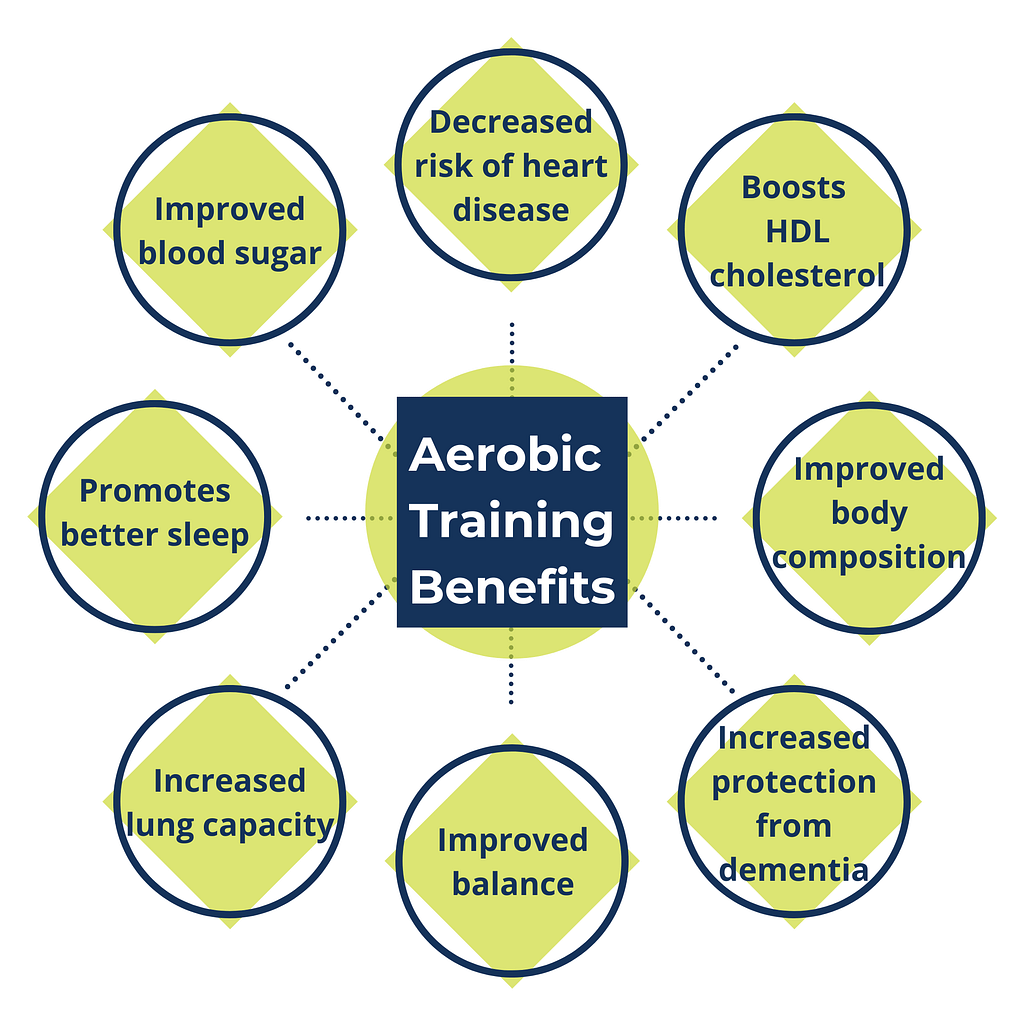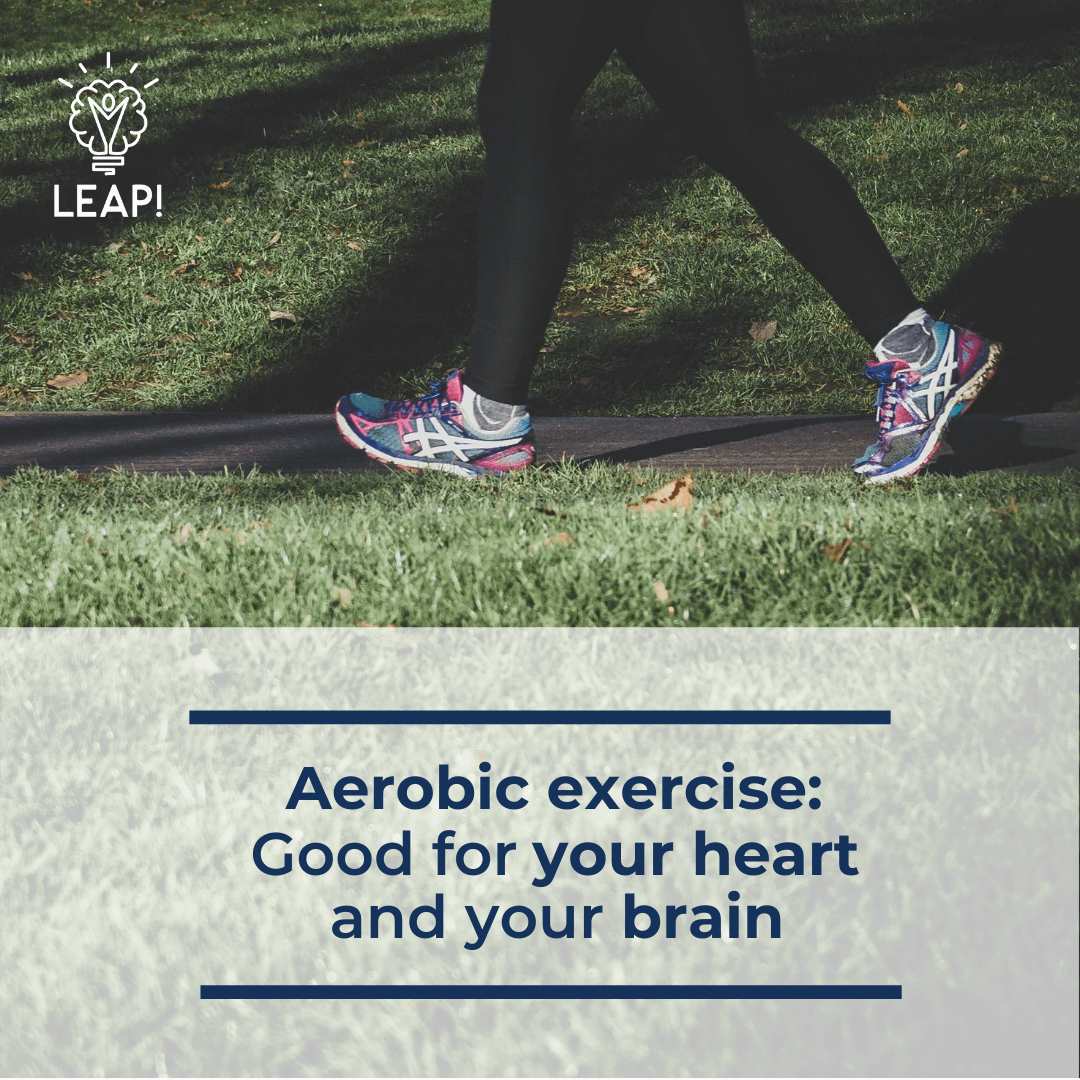In last month’s post, we discussed in detail what strength training is—what types exist, how it impacts brain health, and where to start your journey.
This month, we’re shifting gears to talk about aerobic exercise. These are movements that help increase endurance and improve cardiorespiratory fitness, such as walking, biking, and jogging.
But aerobic exercise isn’t just about caring for your heart, it’s about giving your brain a boost, too!
More studies are now showing that cardiorespiratory fitness is linked to brain health—the healthier our hearts are, the more resilient our brains can be. This tells us there’s promise in reducing our risk by getting our weekly bouts of aerobic exercise.
The recommendations for aerobic exercise are 150 minutes a week. But if you’re a beginner and this number seems unattainable, there’s good news! One 2015 study (from our very own KU ADC!) suggests that even a moderate amount of 75 minutes a week can provide cognitive benefits¹.
Nonetheless, once you build more endurance and nail a routine of moving daily, aim for the full 150 minutes of aerobic exercise a week to reap maximum health benefits.
Just how is aerobic exercise linked to brain health?
Most studies find that aerobic exercise helps protect certain areas in the brain that are susceptible to changes associated with dementia—such as the hippocampus.
In older adults, the volume of the hippocampus shrinks about 1 to 2 percent annually, even without symptoms of dementia². Exercise can help mitigate this decline. Additionally, exercise can help increase gray and white matter in the prefrontal cortex, another crucial area in the brain².
These studies come from a study of 120 older adults—half of whom participated in an exercise program for one year, the rest completing a stretching program. Those who exercised showed moderate improvements in their hippocampus and on spatial memory tests².
As for individuals who have already developed symptoms of dementia, aerobic exercise can still provide cognitive benefits!
In one 2020 study, participants over 60 years of age with current cognitive problems experienced memory improvements after a year of aerobic training³. Thus, exercise can be an effective medicine that helps slow the progression of dementia.
What exercise is considered aerobic?
Any exercise that is performed continuously at a low to moderate intensity over a longer period of time (minimum 20 to 30 minutes) is aerobic. Aerobic exercise works the heart, lungs, and larger muscles.
Can you think of some types of aerobic exercise that you enjoy? Check out some of our favorite ways to break a sweat!

1. Swimming
Swimming as a form of exercise is highly recommended for older adults—especially for those who have arthritis or osteoporosis. That’s because swimming has a light impact on your bones and joints! Additionally, swimming helps build your strength and increase your range of motion.
Are you a beginner? Here are 5 simple exercises from the American Senior Communities blog to try in the pool.
If you already swim, check out these tips from Silver Sneakers to improve your water workouts.
And if you’re wanting to try something new, look for water aerobics classes at your local fitness facility. This is perfect if you’re skeptical about doing swim workouts on your own!
2. Dancing
“Dance fitness,” as it’s commonly called now isn’t the stereotypical aerobics from the 80s with leotards and leg warmers—now, classes are offered for every music style and level of fitness. This means you can find a class for a good workout that fits your needs!
As an added bonus, dance may have additional cognitive benefits than other forms of exercise.
One 2017 study found slightly more improvements in hippocampal volume in participants who completed a dance exercise program than a traditional aerobic exercise program⁴. Research suggests this could be due to music and rhythmic movements, which make dance a total sensory experience. Additionally, dance fitness is also great for improving balance, which reduces the risk of falls.
Most fitness facilities that offer dance cardio will have low-impact class options for older adults— and maybe even offer classes that have participants sit in chairs while completing arm and leg movements. Be sure to do your research before attending for the first time.
If you’re staying home, however, here are some resources for a dance session in your living room!
Before you get started, warm up and learn some basics from this Silver Sneakers dance warm up.
For a 20-minute Latin-inspired cardio workout, check out this video from Senior Fitness with Meredith.
Another YouTube resource, Fitness with Cindy offers a video playlist of different dance style workouts for 10, 20, or 30-minute sessions!
3. Circuits
Most will associate aerobic exercise with repetitive, constant movement, such as using an elliptical machine or a stationary bike. This can get a bit boring, so cardio circuits are an excellent way to change things up!
Circuit training involves performing 5 to 10 exercises for a certain amount of time, about 20 to 60 seconds each. Circuits can be completed continuously, resting in between each round of movements, or with intervals (i.e. exercise 30 seconds, rest 30 seconds).
A workout involving circuits could be done for time (in a 10 or 15-minute bout) or for rounds (3 to 5 rounds). The benefits of circuit workouts are that they can be completed in a short amount of time, they can raise your heart rate quickly, and they often require little to no equipment—perfect for home!
Be mindful, however, as circuit training can be too intense for beginners, and may not be ideal for those with high blood pressure. Be sure to talk with your doctor if you are considering this type of exercise.
If you are ready to complete a circuit workout, start with low-impact movements you feel safe doing. When that becomes easy, gradually increase your intensity by adding more reps, increasing time, or trying more advanced exercises!
Here’s a 25-minute workout from Body Project on YouTube that’s tailored for older adults and beginners. Movements can be completed seated or standing.
For some short, 10-minute workouts, click here for a video list from More Life Health Seniors.
Senior Fitness with Meredith also has a variety of cardio workouts for different levels.
4. Walking
Walking may be simple, but it leads to big impact. What’s more, it gives you a reason to step outdoors!
The benefits of walking include a boosted mood, better balance and coordination, and reduced risk of heart disease and diabetes. Though it can be easy to keep the same walking routine, we encourage you to find ways to challenge yourself for ultimate health benefits.
Read these 9 ways to vary your walking workout from Silver Sneakers. Challenges include changing your footwork, focusing on your breathing, adding resistance, and more!
Check out these Walk at Home workouts from Youtube—workouts range from 15 to 45 minutes and offer varying intensities.
Tips for achieving your best aerobic workout
1. Gear up
Aerobic activities last about 30 to 60 minutes, but it likely won’t take long before you break a sweat! It’s important to wear proper clothing that’s comfortable and breathable, especially if you are in a hot environment.
Perhaps the most important investment you can make is buying a good pair of athletic shoes. This can be tricky, but with a little research and the advice of a professional, you can find your best fit.
Click here for a Silver Sneakers guide to purchasing workout shoes.
Read some more tips here from the American Orthopaedic Foot & Ankle Society.
If you have current foot pain or other health issues that affect what type of shoe you should wear, don’t hesitate to consult your doctor. Remember, a good shoe will help prevent injury!
What about workout tops and bottoms?
As for tops and bottoms, choose clothing you can move in that’s made from breathable fabric. If you’re on a budget, opt out of name brands or buy second-hand—a proper fit is what’s most important!
Lastly, consider your environment. Select light, moisture-wicking clothing if you’re outside in the heat (don’t forget sun protection!) and layer up if you’re going to be out in the cold.
For more information on selecting workout clothes, check out the video below from the National Institute on Aging.

2. Warm up
Warming up before starting a workout is especially important for preventing injury. A good warm-up should raise your heart rate, break a sweat, and prepare your muscles for movement. This is best achieved with dynamic stretches that involve full range of motion.
For a simple, 10 to 15-minute routine (which is about how long a warm-up should last) click here.
For a video warm-up to follow along to, click here.
3. Hydrate
Don’t just hydrate during your workout—make sure you hydrate before and after, especially if you exercise outside in the heat. In general, you’re encouraged to drink half your weight in ounces, but be sure to drink more as you start to exercise regularly.
4. Cool down and stretch
Just like you warm up to acclimate your muscles to exercise, it’s important to cool your muscles down at the end of an exercise session as well. The purpose of a cool-down is to gently lower your heart rate back to normal, to relax your muscles, and to help prevent soreness.
Most movements during a cool-down involve static stretches. This is the perfect time to focus on your flexibility, which is also part of a healthy fitness routine!
Here’s 4 cool-down stretches from the National Institute of Aging.
Try these 7 stretches from Silver Sneakers.
Remember, aim to hold any stretch for 10 to 30 seconds. Avoid bouncing, and only reach far enough to challenge yourself without reaching a point of pain. Stretching helps improve your overall exercise performance!
5. Track your progress
As we’ve emphasized, some exercise is better than no exercise. Is your walk from your car to the grocery store all the exercise you currently do? Start small!
Perhaps you start with taking a 15-minute walk around your block 3 times a week. On week 2, add 5 minutes. Then, add another session. The fourth week, increase your intensity (we suggest checking out one of the previous links in this post!).
Or maybe you currently exercise, but you’ve had the same routine for the past year. (Remember, your body can get used to the same workouts, so you want to make progressions for optimal health benefits.) Try out a new group fitness class, check out some of the resources we shared, or find a friend to challenge each other.
Ultimately, the goal is to get as close as possible to 150 minutes of aerobic exercise each week—and once you manage to hit that, focus on improving your individual performance.
As always, seek medical clearance before starting any exercise program. If possible, work with a certified trainer, especially if you are new to exercise and need additional pointers. We hope this motivates you to get moving for a healthier heart, a more resilient brain, and a happier you!
References
- Vidoni, A.D. et al. Dose-response of aerobic exercise on cognition: A community-based, pilot randomized controlled trial. (2015). PLOS ONE, 10(7). Doi: 10.1371/journal.pone.0131647
- Erickson, K.I. et al. Exercise training increases size of hippocampus and improves memory. (2011). Proceedings of the national academy of sciences of the USA, 108(7), pp. 3017-3022. Doi: 10.1073/pnas.1015950108
- UT Southwestern Medical Center. Exercise improves memory, boosts blood flow to brain: Study: 1-year workout program shows benefits for older people at risk of dementia. (2020). Retrieved from https://www.sciencedaily.com/releases/2020/05/200520084123.htm
- Rehfeld, K. Dancing or fitness sport? The effects of two training programs on hippocampal plasticity and balance abilities in healthy seniors. (2017). Frontiers in human neuroscience. Doi: 10.3389/fnhum.2017.00305


